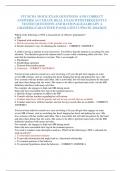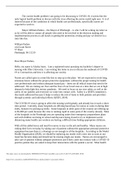FIT BCBA MOCK EXAM QUESTIONS AND CORRECT
ANSWERS| ACCURATE REAL EXAM WITH FREQUENTLY
TESTED QUESTIONS AND RATIONALE|ALREADY A
GRADED|GUARANTEED PASS|LATEST UPDATE 2024/2025.
Which of the following is NOT a characteristic of effective punishment?
a. FR1
b. Unpaired with reinforcement
c. Slowly increasing the intensity of the punisher over time
d. Ensure alternative ways of obtaining the reinforcer - CORRECT ANSWER C
A child is having a tantrum in your classroom. You believe that the tantrum is occurring for your
attention. You therefore ignore the tantrum until it ceases while continuing daily activities. You
note that the tantrums decrease over time. This is an example of:
a. Punishment
b. Establishing operation
c. Timeout from reinforcement
d. Extinction - CORRECT ANSWER D
You have been asked to consult on a case involving a 10 year old girl who engages in some
severe SIB at home, such as scratching her head, banging her head, and poking her eyes. She
lives at home with her mother and father. She is nonverbal, but will take her parents by the hand
and show them things that she wants. She seems to be able to perform many tasks, but the SIB
definitely interferes with many activities.
For example, she engages in high-rate SIB during meals.
Select the most reasonable first step in the treatment process.
a. Quickly design a program to address the SIB
b. Consult with her teachers regarding her self-esteem
c. Conduct interviews with the parents and ask for any records that are available
d. Conduct interviews with her teachers and ask for any records that are available - CORRECT
ANSWER C
You have been asked to consult on a case involving a 10 year old girl who engages in some
severe SIB at home, such as scratching her head, banging her head, and poking her eyes. She
lives at home with her mother and father. She is nonverbal, but will take her parents by the hand
and show them things that she wants. She seems to be able to perform many tasks, but the SIB
definitely interferes with many activities.
For example, she engages in high-rate SIB during meals.
Select the most reasonable first step in the treatment process.
You wish to conduct some descriptive analyses. Which of the following is NOT a rationale for
such an activity?
a. To determine functional relations
b. To provide information that might lead to a functional relationship
c. To examine patterns of the behavior
d. To generate hypotheses about the behavior - CORRECT ANSWER A
,You have been asked to consult on a case involving a 10 year old girl who engages in some
severe SIB at home, such as scratching her head, banging her head, and poking her eyes. She
lives at home with her mother and father. She is nonverbal, but will take her parents by the hand
and show them things that she wants. She seems to be able to perform many tasks, but the SIB
definitely interferes with many activities.
For example, she engages in high-rate SIB during meals.
Select the most reasonable first step in the treatment process.
At first, you are puzzled by the behavior. You therefore work with the child, and then let the
hypotheses evolve from your data. This example demonstrates the process of:
a. Induction
b. Deduction
c. Social learning theory
d. Stimulus equivalence - CORRECT ANSWER B
You have been asked to consult on a case involving a 10 year old girl who engages in some
severe SIB at home, such as scratching her head, banging her head, and poking her eyes. She
lives at home with her mother and father. She is nonverbal, but will take her parents by the hand
and show them things that she wants. She seems to be able to perform many tasks, but the SIB
definitely interferes with many activities.
For example, she engages in high-rate SIB during meals. To conduct your descriptive analysis,
you realize that someone should consent to the process. From whom should you obtain consent?
a. The child
b. The parents
c. The teachers
d. Both the child and the parents - CORRECT ANSWER D
You have been asked to consult on a case involving a 10 year old girl who engages in some
severe SIB at home, such as scratching her head, banging her head, and poking her eyes. She
lives at home with her mother and father. She is nonverbal, but will take her parents by the hand
and show them things that she wants. She seems to be able to perform many tasks, but the SIB
definitely interferes with many activities.
For example, she engages in high-rate SIB during meals. During some of your interviews, the
parents report that the behavior began about 2 years ago when the child was afflicted with a
serious intestinal bacterial infection. What should be your next step?
a. Include that fact in your analysis
b. Immediately ask for a medical exam that looks at the status of the infection
c. Conduct a functional analysis of the current reinforcers
d. Report the problem to child protective services - CORRECT ANSWER B
You have been asked to consult on a case involving a 10 year old girl who engages in some
severe SIB at home, such as scratching her head, banging her head, and poking her eyes. She
lives at home with her mother and father. She is nonverbal, but will take her parents by the hand
and show them things that she wants. She seems to be able to perform many tasks, but the SIB
definitely interferes with many activities.
,For example, she engages in high-rate SIB during meals. One of the tools that you wish to use is
a pattern analysis. Which best exemplifies this method?
a. Have the parents record a narrative during the day so that you can examine the behavior and
the situations under which it occurs.
b. Have the parents record behaviors and the time that they occur during the day
c. Set up an ABC format sheet and have the parents record behavior
d. Allow the parents to tally the data frequencies and the antecedents they ob - CORRECT
ANSWER B
You have been asked to consult on a case involving a 10 year old girl who engages in some
severe SIB at home, such as scratching her head, banging her head, and poking her eyes. She
lives at home with her mother and father. She is nonverbal, but will take her parents by the hand
and show them things that she wants. She seems to be able to perform many tasks, but the SIB
definitely interferes with many activities.
For example, she engages in high-rate SIB during meals. From your descriptive analysis, you
generate many kinds of information. You would like to have some rate data across days. How
might you do this?
a. Plot the number of occurrences of the behavior
b. Count the number of occurrences and plot them by the situation in which they occurred
c. Count the number of occurrences and divide by the recording time each day
d. Count the number of occurrences and multiply it by the dependent variable - CORRECT
ANSWER C
The results of your descriptive analysis suggest that the SIB occurs when the mother is not in
close proximity to the child. Thus, she begins to injure herself anytime the mother leaves her
side. Data also show that in general, SIB is followed by mother returning to the child.
You wish to do some systematic manipulations to confirm the hypothesis. Which of the
following best exemplifies this?
a. Collect and organize ABC data
b. Have mom remain close to the child. Then have her leave the child's side. Count SIB when the
child is close to mom and when mom is not close by.
c. Examine ABC data and look for SIB when mom is close by and when mom is not.
d. Examine SIB in and out of task. - CORRECT ANSWER B
The results of your descriptive analysis suggest that the SIB occurs when the mother is not in
close proximity to the child. Thus, she begins to injure herself anytime the mother leaves her
side. Data also show that in general, SIB is followed by mother returning to the child. Which of
the following is the best rationale for conducting a systematic manipulation in this case?
a. To collect all of the information possible about the SIB
b. To provide the most reliable information about the function of the SIB
c. To provide external validity information
d. To provide some inductive reasoning for the assessment - CORRECT ANSWER B
The results of your descriptive analysis suggest that the SIB occurs when the mother is not in
close proximity to the child. Thus, she begins to injure herself anytime the mother leaves her
side. Data also show that in general, SIB is followed by mother returning to the child. In the
, systematic manipulation, you indeed see that the child quickly engages in SIB as soon as the
mom leaves her side. In fact, it starts up within 1-2 seconds after the mom gets up to leave. These
are examples of what kind of data?
a. Rate
b. Latency
c. Duration
d. Partial interval recording - CORRECT ANSWER B
The results of your descriptive analysis suggest that the SIB occurs when the mother is not in
close proximity to the child. Thus, she begins to injure herself anytime the mother leaves her
side. Data also show that in general, SIB is followed by mother returning to the child. Your
systematic manipulations confirm that the behavior occurs whenever the mom leaves the child's
side. The next step is to design an intervention.
Which of the following is the best approach to design an intervention?
a. Slowly fade the mom's presence from the child
b. Teach the child kid to engage in activities without mom close by. Use food as the reinforcer.
c. Teach the child to engage in activities without mom close by. Use proximity to mom as the
reinforcer.
d. Reinforce independent functioning and use overcorrection for SIB. - CORRECT ANSWER C
The results of your descriptive analysis suggest that the SIB occurs when the mother is not in
close proximity to the child. Thus, she begins to injure herself anytime the mother leaves her
side. Data also show that in general, SIB is followed by mother returning to the child. You would
like to use a reinforcer for independent functioning. The question is how long do you ask her to
perform these activities before the reinforcer is delivered? What kind of data do you need to
answer that question?
a. Latency of SIB after mom leaves
b. Duration of SIB episodes
c. Rate data
d. Trails to criterion - CORRECT ANSWER A
The results of your descriptive analysis suggest that the SIB occurs when the mother is not in
close proximity to the child. Thus, she begins to injure herself anytime the mother leaves her
side. Data also show that in general, SIB is followed by mother returning to the child. A main
question is how to address the SIB as well as what to do when the SIB occurs. Select the best,
most reasonable approach in this case.
a. Overcorrection in which the child practices signing for mom's attention
b. Implement Isolation timeout each time SIB occurs
c. Gradually decrease the mother's proximity and prevent or block SIB as necessary; also train a
functionally equivalent replacement behavior to access mom's attention
d. Ignore the SIB until it extinguishes - CORRECT ANSWER C
The results of your descriptive analysis suggest that the SIB occurs when the mother is not in
close proximity to the child. Thus, she begins to injure herself anytime the mother leaves her
side. Data also show that in general, SIB is followed by mother returning to the child. Another





